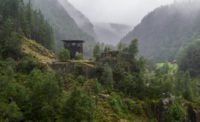Cindy Regnier, manager of the world's first research laboratory for full-scale performance mock-ups of integrated green-building systems, is canvassing the globe to find partners and research sponsors for the facility, called FLEXLAB. Regnier is bent on doing her part to create a new paradigm for energy conservation in buildings. And she is using the lab as a springboard.
She seems to be succeeding. The $15.7-million FLEXLAB, which stands for "Facility for Low-Energy Experiments in Buildings," is still under construction on the campus of the U.S. Energy Department's Lawrence Berkeley National Laboratory in Berkeley, California. Yet researchers in Norway and Singapore are so impressed with the idea of multisystem validation tests for energy conservation in office buildings that they already are planning to build FLEXLAB clones. "It's exciting to see that, before we're even operational, we're having an impact abroad," says Regnier.
FLEXLAB is different from all other test facilities because users can reconfigure its "plug-n-play" test beds, swapping in different cladding systems, windows, sunscreens, lighting, and mechanical systems. This has caught researchers' attention. "Facilities like FLEXLAB are very important for reaching the policy goals set for energy efficiency in the buildings sector as these facilities will enable research and testing on a level not yet common," says Arild Gustavsen, director of the Research Centre on Zero Emission Buildings at the Norwegian University of Science and Technology.
The center plans to start construction next month on an office-building test bed, modeled after FLEXLAB, and a residential living lab. "We are planning to use the same data acquisition and control system developed for FLEXLAB," says Gustavsen. Singapore's Building and Construction Authority expects to begin construction next year on Asia's first rotational test bed, also modeled on FLEXLAB's. The 11-meter x 11-m test bed will be on the roof of a new building, named BCA Academy, currently under construction. The rooftop location will facilitate the study of building facade design and sun-shading solutions in relation to the sun path pattern in the tropics, says Stephen Mok, deputy director of BCA's Centre for Sustainable Buildings and Construction.
FLEXLAB also has other collaborators, including a non-profit start-up in San Jose, California, called PROSPECT Silicon Valley. Like a matchmaker, the group plans to help connect FLEXLAB researchers with new-system field testers in real, occupied office environments. The goal is to demonstrate the commercial viability of building-energy conservation systems developed at FLEXLAB.




Post a comment to this article
Report Abusive Comment